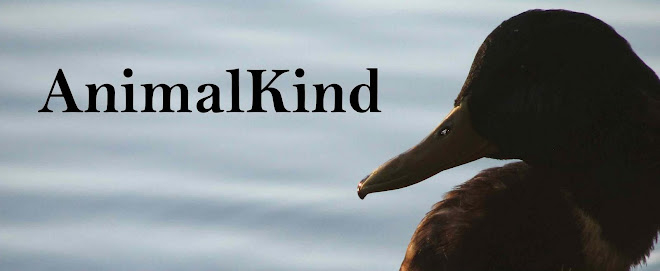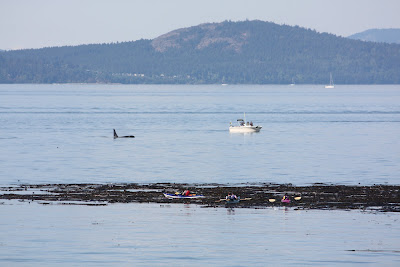One morning I was on my way from my parent's house in Cathlamet, WA to Olympia, WA for an interview. I had to leave early, right before sunrise. The timing could not have been more perfect since I came upon the sun rising along the river in a clearing on the road. It was so amazing I had to pull over and take out my camera. The colors and beauty were outstanding, especially since it started out behind Mt. Saint Helens. Right next to the beauty, was an industrial monster spewing out pollution. Capturing them both together shows a clear contrast between the two, with natural beauty clearing winning.
Saturday, October 27, 2012
Catching the Sunrise
One morning I was on my way from my parent's house in Cathlamet, WA to Olympia, WA for an interview. I had to leave early, right before sunrise. The timing could not have been more perfect since I came upon the sun rising along the river in a clearing on the road. It was so amazing I had to pull over and take out my camera. The colors and beauty were outstanding, especially since it started out behind Mt. Saint Helens. Right next to the beauty, was an industrial monster spewing out pollution. Capturing them both together shows a clear contrast between the two, with natural beauty clearing winning.
Monday, September 17, 2012
Gray Whales in Depoe Bay
 |
| Gray Whale McFlurry flukes in Depoe Bay, OR |
This summer I got to play with whales- Gray whales to be
specific. Although most of their adventures took place under water, I learned a
lot about them and got to know quite a few individuals, not only by their
looks, but their inner beauty as well; or at least character traits.
Carrie Newell is a marine biologist from Depoe Bay, Oregon
who was nice enough to give me an internship this summer and teach me about the
whales and identifying individuals. She has been doing this for about 20 years. I had such a great time! I definitely
recommend taking a whale-watching trip with her through Carrie’s Whale Research EcoExcursions if you get a chance!
 |
| Gray whales have two blowholes unlike toothed whales with one. |
Gray whales are known for their impressive migration every
year from feeding grounds in Alaska, to their breeding and calving grounds in
Baja, Mexico. But not all these whales make it all the way back up to Alaska,
allowing them to cut their trip (and energy resources) down considerably. You
see there are some gray whales that stay around the Pacific Northwest coastline
from spring until fall, feeding close to the shoreline on mysid shrimp (which
Carrie discovered). These whales are what are known as resident gray whales.
These are the whales I got to know this summer. Here are highlights of a few of
them.
 |
| Blanco doing his best fluking behavior. |
Blanco was one of my favorites, mostly because he put on a
good show and was a lady’s man. He always had a new girl he was chasing around.
He was very white in his coloring, which made him stand out easily. But he
seemed incapable of a good fluke. Poor guy.
 |
| Lucky flukes and shows off all the white markings on the side from killer whale tooth marks. |
Lucky got his name due to all the scars he has on his body
from killer whale tooth marks. He is lucky to be alive. He is a younger whale,
probably born this year. Transient killer whales target calves and try and
separate them from their mothers. It is obvious the killer whales got a hold of
Lucky, but somehow his mother was able to fight them off.
 |
| Flipper demonstrates "skarking", a feeding behavior. |
Flipper is a whale that showed up later in the summer and
has stayed around for a while. He gets his name from distinctive marks on both
sides of his body that looks like a dolphin head. He tends to be fairly active
and was recently seen courting a female whale named Comet.
 |
| Aurora swims by. You can see the witch face marking right before her dorsal hump. |
Aurora was the first whale that I had the honor to name. I
found her to be a really beautiful whale and wanted her to have a nice name.
She has a lot of unique marking on her body, including one that looks like a
witch face. But her name comes from marking on her sides that reminded me of
the aurora borealis.
 |
| Fishbone swims by and you can clearly see on his dorsal hump where he gets his name. |
Fishbone appeared for a few days and was even seen courting
with Aurora one day. I felt so honored for the two whales I named to be
crushing on each other. His name was an obvious one. The best experience on the
water I had was watching him play in the seaweed. I got to see his little
flipper and he even opened his mouth above water, allow us all on the boat to
see his baleen filled mouth. What a treat!
 |
| Fishbone plays in some seaweeds. You can see his flipper sticking out to the left. |
You may be wondering why I share all this with you, besides
the fact that whales are so cool! I think it is important to learn about the
creatures of the world so we can gain better respect for them; understand the
ecosystems that surround us; allow us to protect them in the future. Gray
whales were once hunted to near extinction. Luckily their numbers have been
increasing to healthy population levels (but not other whales species), however,
they will never be fully safe in the industrial world we have created.
Over-fishing is occurring right now. Ecosystems the gray whale relies on for
food is being disturbed. Plastic bags are being found in stranded whale
stomachs. Noise is polluting the oceans. We have a lot to overcome in
protecting whales and the oceans, but I do believe the first step is education
and respect.
Location:
Depoe Bay, OR, USA
Thursday, August 9, 2012
"Oh My Greatness"
This morning I woke up on the west side of San Juan Island. The sun was shining and the sky mostly clear. I am camping at San Juan County Park, the most beautiful place to camp on the island which has the most beautifully dramatic sunsets of orange and red. Just sitting, I could see the quick appearance of a black dorsal fin. Before going ape shit, I waited to see it again. I then went ape shit!
I yelled "Orca!" and grabbed my camera bag. I started to run forward and realized there were tents and other campsites in my way, so had to modify my path. There were many orcas going by. I am fairly certain they were a part of the 'J' pod, who just had a newborn join their family this week. Although they were a little offshore, I could see the more yellow coloring on the baby orca, since the white spots take time to lighten. So cute!
For over two hours the orcas came by the park, a few at a time. At first they were just traveling by, but then we got to see some displaying fishing behavior which included tail slaps, breaches and spy hops.
There was a women behind me who explained "Oh my greatness" when she first saw the orcas herself, and I thought, what a perfect way to describe this experience. Campers were bonded over seeing these magnificent creatures, educating each other about the tidbits they knew. A little girl kept screaming out "whales!" for others to hear so every one had the chance to experience them.
I even spotted a research boat and "Tucker", a black lab who sniffs out whale poo to be collected and analyzed. (Orca poo smells like sea weed! And it is green and slimy and liquidy looking.) What an amazing way to start the day!
I yelled "Orca!" and grabbed my camera bag. I started to run forward and realized there were tents and other campsites in my way, so had to modify my path. There were many orcas going by. I am fairly certain they were a part of the 'J' pod, who just had a newborn join their family this week. Although they were a little offshore, I could see the more yellow coloring on the baby orca, since the white spots take time to lighten. So cute!
For over two hours the orcas came by the park, a few at a time. At first they were just traveling by, but then we got to see some displaying fishing behavior which included tail slaps, breaches and spy hops.
There was a women behind me who explained "Oh my greatness" when she first saw the orcas herself, and I thought, what a perfect way to describe this experience. Campers were bonded over seeing these magnificent creatures, educating each other about the tidbits they knew. A little girl kept screaming out "whales!" for others to hear so every one had the chance to experience them.
I even spotted a research boat and "Tucker", a black lab who sniffs out whale poo to be collected and analyzed. (Orca poo smells like sea weed! And it is green and slimy and liquidy looking.) What an amazing way to start the day!
Tuesday, April 10, 2012
Coyotes, Eagles and Nutria

Leaping Coyotes! Today was the closest I've been to a coyote and I was pretty excited about it! There were two of them, both of which crossed the street in front of my car. The coyotes were seen towards the end of the driving route at Ridgefield Wildlife Refuge.

People tend to be intimidated by coyotes since they don't fear humans. These wild animals live in packs and are really quite smart. Coyotes will live where the food is, so if there is an urban population, this is usually due to a person making food available to them.

Nutria are considered an invasive species, but I still think they are super cute.

A song sparrow, I believe. After losing points in my ornithology class for getting a few sparrows' identification wrong, I have decided I don't care, unless they are an obvious white-crowned sparrow.

To the left we have a pied-billed grebe and the other two are coots. Coots were out in large numbers today. They look like simple water birds, but they have unique behaviors (and really bizarre feet!) Females will lay eggs in another coot's nests to take some of the reproductive burden off themselves. If they notice eggs not their own in their nest, they will put the eggs off to the side, and once hatched, kill the young not their own.

A mature bald eagle. It takes at least 3 years for the eagle to reach maturity and get the signature white head and tail. The eagles are starting to pair up for breeding season and many were seen in the refuge.
Monday, March 26, 2012
Spring time is here!

I live in Portland, Oregon and my favorite place to visit is luckily right in the city. The Crystal Springs Rhododendron Gardens is full of animal and plant life all year round. This time of year, trees and flowers are blooming, and the birds are gearing up for breeding season. I took advantage of a sunny day for my first photography outing of spring.





Subscribe to:
Comments (Atom)











